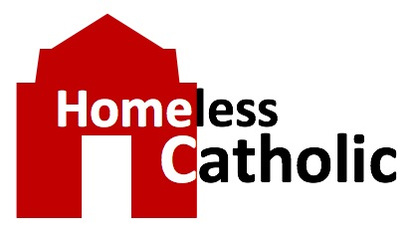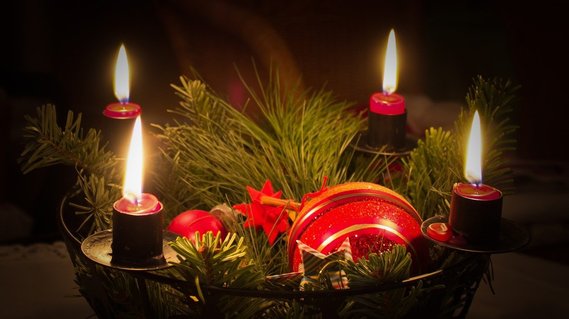Advent and Reconciliation
Though we all struggle with sin as a result of our fallen human nature, we should never forget that our calling is that of perfection. We are called to be perfect as the Father in Heaven is perfect. We are called to recognize our sins, confess them, and strive to become detached from them.
Advent is one of the most important times of year to do this and it is especially important that we seek out the grace of the Sacrament of Reconciliation during this holy Advent season.
Image by Corinna Lichtenberg
Elijah prepares the way for our Advent
By Tim Trainor
https://bible.usccb.org/bible/readings/121121.cfm
Sirach 48:1-4, 9-11
Matthew 17:9a, 10-13
When the Church [that's us] celebrates the liturgy of Advent each year, she makes present the ancient expectancy of the Messiah, for by sharing in the long preparation (hundreds of years) for the Savior's first coming, the faithful renew their ardent desire for his second coming. [also] By celebrating John the Baptist, His precursor's birth and martyrdom, the Church [that's still us] unites herself to John's desire: "He must increase, but I must decrease."
There is always a great sense of anticipation or excitement for us Re-Presenting Christ’s coming into our world. We know the joy, love, and hope that Christ provides, and we are eagerly waiting for Him to re-enter into our lives hopefully MORE fully this year. I think the readings for today take note of this excitement and show that Christmas is truly the event for which we have been hoping and will fulfill our grandest expectations. To put it simply, I think the readings show that Christmas is everything we could possibly expect and even more.
In order to show that Christ’s coming is the fulfillment of our hopeful expectation, the readings make mention of the prophet Elijah several times. We can see that Elijah is a powerful prophet who can “put an end to wrath before the day of the Lord” (Sirach 48:10). I think Elijah is featured in today’s readings because the people of Israel believed he would be the one to prepare the way and usher in their Messiah. Elijah was the one “to turn back the hearts of fathers towards their sons, and to re-establish the tribes of Jacob” (Sirach 48:10) in order to prepare Israel (over those hundreds of years) for their Savior.
Therefore, by connecting John the Baptist with Elijah, today’s Gospel shows us that John is the one called to prepare the way for Jesus, who is the anticipated Savior of Israel and the world. Matthew wants us to realize that Jesus is not some sudden promise or unheralded king. Jesus is the one whom we have prayed and waited for, and His arrival has been prepared by all the prophets, including Elijah over 100s of years and now John the Baptist as the last Prophet!
Since we know that Jesus is our long-awaited King and Savior, we are called to prepare ourselves to greet and welcome Him at Christmas. The Responsorial Psalm beautifully proclaims our need to invite Christ when it says, “Lord, make us turn to you; let us see your face and we shall be saved” (Psalm 80:8). We know that Jesus is the perfect end of our hopeful desire; now, we must use this time to open ourselves to receive Him – TO GET READY!
As we continue to reflect upon St. John the Baptist, we see that his role of being Elijah was missed by the scribes. They failed to see him fulfilling Elijah’s role of preparing the way for the Lord.
Though John had a unique and definitive role in preparing for the coming of Christ, so also do each one of us have a role in preparing ourselves for His continual coming. Jesus came once many years ago, but He desires to continue coming into our lives. And He can only come if we properly prepare for Him.
To prepare the way of the Lord we might heed the two (2) main messages of John.
His first message was to repent of our sin.
Though we all struggle with sin as a result of our fallen human nature, we should never forget that our calling is that of perfection. We are called to be perfect as the Father in Heaven is perfect. We are called to recognize our sins, confess them, and strive to become detached from them. Advent is one of the most important times of year to do this and it is especially important that we seek out the grace of the Sacrament of Reconciliation during this holy Advent season.
Did you know that Our Lady of the Woods Church has an Advent Penance Service scheduled for next Wednesday December 15th at 6pm? Please think about taking advantage of this offer.
His second message was: "He must increase, but I must decrease."
So often, it is easy for us to want to hold onto our own positions or roles. We expend a great deal of effort trying to protect those roles and keep them for ourselves. John shows us by his example that there is a much better way. John shows us how to graciously step aside to allow others to fulfill their roles.
Also and even more importantly, when John says, “He must increase, but I must decrease,” he is modeling for us How to let God's will govern more in our lives and that we each need to humble our own will [decrease it] before God as we say it the “Our Father” prayer.
Embracing repentance in this holy season is the best way that I know of to prepare for the coming of Christ into your life at Christmas this year.
Advent, which begins the Church’s liturgical year, began on Sunday, December 3, and encompasses the four Sundays and weekdays leading up to the celebration of Christmas. It is a time of preparation for our hearts and minds for the anniversary of the Lord’s birth on Christmas. The use of the Advent Wreath and candles during Advent are a longstanding Catholic tradition that was originally adopted by Christians in the Middle Ages as part of their spiritual preparation for Christmas.
The wreath and candles are full of symbolism tied to the Christmas season. The wreath itself, which is made of various evergreens, signifies continuous life. The circle of the wreath, which has no beginning or end, symbolizes the eternity of God, the immortality of the soul, and the everlasting life we find in Christ.
Even the individual evergreens that make up the wreath have their own meanings that can be adapted to our faith. The laurel signifies victory over persecution and suffering. The pine, holly, and yew signify immortality and the cedar signifies strength and healing. The pine cones that decorate the wreath symbolize life and resurrection. The wreath as a whole is meant to remind us of both the immortality of our souls and God’s promise of everlasting life to us through Christ.
The candles also have their own special significance. The four candles represent the four weeks of Advent, and one candle is lit each Sunday. Three of the candles are purple because the color violet is a liturgical color that signifies a time of prayer, penance, and sacrifice.
The first candle, which is purple, symbolizes HOPE. It is sometimes called the “Prophecy Candle” in remembrance of the prophets, especially Isaiah, who foretold the birth of Christ. It represents the expectation felt in anticipation of the coming Messiah.
The second candle, also purple, represents FAITH. It is called the “Bethlehem Candle” as a reminder of Mary and Joseph’s journey to Bethlehem.
The third candle is pink and symbolizes JOY. It is called the “Shepard’s Candle,” and is pink because rose is a liturgical color for joy. The third Sunday of Advent is Gaudete Sunday and is meant to remind us of the joy that the world experienced at the birth of Jesus, as well as the joy that the faithful have reached the midpoint of Advent.
On this Sunday, priests change into rose colored vestments to help remind us move into the last phase of Advent in a joyful spirit.
And finally, on the fourth week of Advent, we switch back to purple colored candles and vestments and light the final candle to mark the final week of prayer and penance as we wait for the birth of our Savior.
This final candle, the “Angel’s Candle,” symbolizes PEACE. It reminds us of the message of the angels: “Peace on Earth, Good Will Toward Men.”
I’m ready to do Advent!

